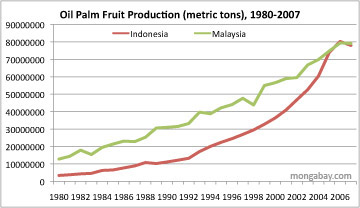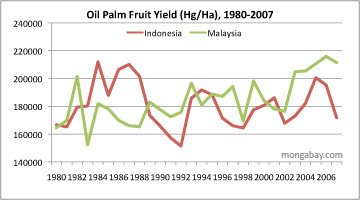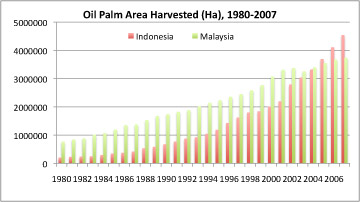Indonesia has 18 million hectares of land suitable for oil palm cultivation, nearly twice the 9.7 million hectares that have already been allocated for plantations, said Agriculture Minister Suswono said at the opening of the 5th Indonesian Palm Oil Conference in Bali.
“Based on the land characteristics and the climate, we have a total of 18 million hectares of land, including the existing 9.7 million hectares, that potentially could be used for palm oil plantations, without disturbing our forest preservation efforts,” Suswono was quoted as saying by the Jakarta Post.
   All data from FAOstat |
Roughly 7.9 million hectares of the allocated area has already been planted with oil palm.
The minister said Indonesia p[lans to both expand plantations and increase the yields of existing plantations. Indonesia’s palm oil industry is only about 60 percent as that of Malaysia productive of Malaysia, which is the second largest producer of palm oil.
Suswono attributed the difference to Indonesia’s newer plantations as well as greater corporate control over operations in Malaysia. Plantations run by communities and smallholders produce less fruit per unit of area than larger plantations run by the government (4-5 tons per hectare) and private companies (7 tons per hectare).
Oil palm expansion in Indonesia promises to be controversial due to environmental concerns. In February the government approved a decree that will allow the conversion of up to 2 million hectares carbon-rich peatlands, a move scientists warn could trigger the release of hundreds of millions of tons of CO2. But palm oil producers argue that oil palm cultivation is presently the most profitable form of land use on peatlands and that as the highest-yielding oilseed, palm oil providing a low-cost alternative for food production.
But economic returns from oil palm plantations could soon face competition under a scheme (known as REDD for reducing emissions from deforestation and degradation) that would compensate countries for protecting carbon sinks, notably tropical forests and possibly peatlands. Under some circumstances carbon conservation could outperform palm oil production.
Indonesia’s recent announcements about oil palm expansion across peatlands may in fact be posturing to win more compensation under a REDD mechanism.
Related articles
Palm oil companies trade plantation concessions for carbon credits from forest conservation
(07/22/2009) Indonesian palm oil producers are eying forest conservation projects as a way to supplement earnings via the nascent carbon market, reports Reuters.
(06/04/2009) Indonesia’s decision earlier this year to allow conversion of up to 2 million hectares of peatlands for oil palm plantations is “a monumental mistake” for the country’s long-term economic prosperity and sustainability, argues an editorial published in the June issue of Frontiers in Ecology and the Environment.
Can carbon credits from REDD compete with palm oil?

(03/30/2009) Reducing emissions from deforestation and degradation (REDD) is increasingly seen as a compelling way to conserve tropical forests while simultaneously helping mitigate climate change, preserving biodiversity, and providing sustainable livelihoods for rural people. But to become a reality REDD still faces a number of challenges, not least of which is economic competition from other forms of land use. In Indonesia and Malaysia, the biggest competitor is likely oil palm, which is presently one of the most profitable forms of land use. Oil palm is also spreading to other tropical forest areas including the Brazilian Amazon.